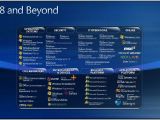"Now is the time and the time is now." This is the introduction Microsoft Product Manager Nick White tied to the company's first initiative designed to make public details about the first service pack for Windows Vista. Carrying somewhat of the weight of a slogan, the time reference is far away from the impulse built into the Wow. I don't know if you still remember but "Wow is Now" was made synonymous with the launch of Vista in late January 2007. Quite a limp Wow, outperformed in the Vista delivery by the impact of Apple's iPhone for example and a marketing campaign which failed to gain or even keep a healthy momentum. Seven months after the consumer launch of Windows Vista the Wow is referenced less and less having faded into the background, while the operating system is slowly grinding and eroding Windows XP from its dominant position on the operating system market instead of dislodging it as an obsolete and expired platform.
Wow Reloaded, No Sooner than Next Year
Microsoft's second take at the Windows Vista Wow is scheduled for the first quarter of 2008. The company failed to put an accurate date on the release but just because it is not entirely up to Microsoft. "We're targeting the first quarter of 2008, but the exact date really depends on feedback we receive from testers and the work we put into making sure we understand the feedback we receive," explained Jon DeVaan, Senior Vice President of the Windows Core Operating System division at Microsoft. Of course that the Redmond company, in its long tradition of hinting (notice that I am not using the term leaking, and have opted for an euphemism) future development directions, revealed the 2008 release date for Vista SP1 since the Financial Analyst Meeting 2007 in July. Notice that in the chronological enumeration of client and server milestones for the 2008 fiscal year, Vista SP1 is placed well after Windows Server 2008, formerly codenamed Longhorn. Although since July Microsoft indeed postponed the release to manufacturing Windows Server 2008 until the first quarter of 2008, the launch date remains set at the end of February 2008.
So your best estimates are that, if Microsoft delivers Vista SP1 at the end of February, you still have to wait six months beginning now for the refresh. In other words Microsoft has made a decisive move to catalyze Vista adoption before the service pack drops. It remains to be seen if the decision will or will not prove a gambit for the Redmond company. And just in case that you are hopping for Vista SP1 before Windows Server 2008, don't! The reason? Well the first service pack for Vista and Windows Server 2008 are intimately connected, via the 6.1 kernel.
"Windows Vista and Windows Server 2008 have been built from the same fundamental source code base since the beginning. Many of the core files are identical between the two products, although each product has unique features, specific individual files and functional behaviors that are appropriate for the intended customer uses for the specific product. For example, Windows Media Center only appears in Windows Vista, while Active Directory or Windows Clustering only appear in Windows Server 2008. Examples of common files shared between the two operating systems are the kernel and core OS files, the networking stack, file sharing. In the past year since the Windows Vista public release, the common files in Windows Vista and Windows Server 2008 have been continually improved based on customer beta feedback, customer deployments, and Microsoft internal testing," explained Microsoft's Brandon LeBlanc.
Windows Server 2008 is currently in Beta 3 stage and Microsoft was planning to RTM its last 32-bit server operating system by the end of the year. This is no longer the case. And currently the company's best estimates for Windows Server RTM are the first quarter of 2008. Coincidentally, the first quarter of the upcoming year is also the release date for Windows Vista SP1. Right... there is little coincidence here. At this point in time Microsoft plans to make the full beta of Vista SP1 available for download to MSDN and TechNet subscribers by the mid September. The company will also deliver a public testing build around the time it will move into the release candidate phase of the SP1. Indications point to later this year, but that is anyone's guess right now.
Vista SP1 - The Dying Breed of the Service Pack
Vista SP1 will not be a vessel for new features. This just to know what not to expect from the service pack. In no manner is Vista SP1 a repeat of Windows XP Service Pack 2. As a matter of fact XP SP2 was an exception from the service pack course over at Microsoft and in this respect not even SP3 will bring anything new to the platform launched in 2001 and last updated in 2004. But this does not mean that Microsoft is not growing Windows Vista. In this regard the company downplayed service pack releases as only an accessory to its update infrastructure. Windows Update, Windows Server Update Services (WSUS), the Download Center are all applauded as viable alternatives to the traditional service pack. This does by no means imply that Microsoft will discontinue the practice of refreshing its software products through the release of service packs.
According to Microsoft nowhere is the continuous evolution of Windows Vista outside of service pack releases more evident than in the areas of application compatibility and device driver support. Programs featuring the Works with Windows Vista or certified for Windows Vista logo programs have increased steadily in volume from 254 in November 2006, the month the operating system was released to businesses, to 652 in January, to 1,709 in June and to 2,076 in July. As far as device drivers are concerned, at the end of July Vista included over 2.2 million items, up 700,000 from the 1.5 million drivers supported in November 2006.
"Our primary focus after launch became addressing ecosystem compatibility issues that the data showed had adversely impacted some users' Windows Vista experience," DeVaan added. "Our driver coverage went from 1.4 million in January to more than 2.2 million today. We also work directly with our partners to improve overall driver quality. We are able to see which drivers are causing system crashes or contributing to hangs and other performance problems, and then work across the ecosystem to bring solutions to market via Windows Update. (...) When we built Windows Vista, the changes necessary to make it more secure did cause some application compatibility challenges, but we think it was a worthwhile trade-off. Windows Vista was tested with thousands and thousands of applications, the majority of which are perfectly compatible, and that the number of applications carrying the Windows Vista logo, which assures a good experience, recently passed 2,100 and continues to grow every day."
Brand New Shiny and Improved Vista
Microsoft has applauded Vista as an epitome of security, reliability and performance. Well, guess what. SP1 will continue to keep the operating system at an apex. The service pack will not only include a collection of all the previously released updates for the platform but will also fix problems highlighted via the Vista instrumentation used to collect automated feedback and inputs such as the Customer Experience Improvement Program (CEIP) and Online Crash Analysis (OCA). All the enhancements will serve to increase the overall quality of the operating system and improve user experience.
In terms of security Microsoft has evolved the communication path between third-party solutions and the Windows Security Center. Additionally the Redmond company will deliver on its promise to provide a set of application programming interfaces (APIs) to the security industry designed to permit developers to integrate their products with kernel patch protection on x64 versions of Windows Vista, outside of the practice of kernel patching. Vista SP1 also "Improves the security of running RemoteApp programs and desktops by allowing Remote Desktop Protocol (RDP) files to be signed. Customers can differentiate user experiences based on publisher identity. Adds an Elliptical Curve Cryptography (ECC) pseudo-random number generator (PRNG) to the list of available PRNGs in Windows Vista. Enhances BitLocker Drive Encryption (BDE) to offer an additional multifactor authentication method that combines a key protected by the Trusted Platform Module (TPM) with a Startup key stored on a USB storage device and a user-generated personal identification number (PIN)," LeBlanc added citing the Windows Vista Service Pack 1 Beta White Paper.
Reliability improvements will deal with the most common array crashes and hanging problems the operating system experienced. Microsoft promised improved reliability and compatibility with the latest graphics cards and also in scenarios involving work with external displays from laptops running Vista, in certain networking configuration cases, on systems that upgraded from XP and resolves for issues associated with the Sleep mode. Microsoft also offered a list with the evolution planned for Performance, the Administration Experience and for Emerging Hardware and Standards:
- Improves the speed of copying and extracting files; time to become active from Hibernate and Resume modes; the performance of domain-joined PCs when operating off the domain; the performance of Internet Explorer 7 in Windows Vista, reducing CPU utilization and speeding JavaScript parsing, Improves battery life by reducing CPU utilization by not redrawing the screen as frequently, on certain computers and the logon experience by removing the occasional 10-second delay between pressing CTRL-ALT-DEL and the password prompt displaying. - Addresses an issue in the current version of Windows Vista that makes browsing network file shares consume significant bandwidth and not perform as fast as expected. - BitLocker Drive Encryption encrypts extra local volumes. - Addresses problems with printing to local printers from a Windows Terminal Services session. - The Network Diagnostics tool will help customers solve the most common file sharing problems, in addition to the basic problems that it already diagnoses. - Administrators can control the volumes on which to run Disk Defragmenter. - In the future, flash memory storage and consumer devices will use the exFAT file system. Windows Vista SP1 adds support for this file system to Windows Vista. - The service pack will include support for Secure Digital (SD) Advanced Direct Memory Access (DMA), which will be on compliant SD host controllers soon, to improve transfer performance and decrease CPU utilization. - x64 PCs can boot using the EFI. Windows Vista currently supports network boot by using Windows Deployment Services for x86, a PC's basic input/output system (BIOS) for x64 PCs, and EFI for IA-64 PCs. Windows Vista SP1 will add support for network boot by using x64 EFI. - The service pack will add support for Direct3D 10.1, adding application programming interfaces (APIs) and features that enable 3-D applications, so game developers can better take advantage of a new generation of Direct3D graphics hardware. - The Secure Socket Tunneling Protocol (SSTP) is a remote access tunneling protocol that will be part of the Routing and Remote Access Service (RRAS) platform.
Welcome to the All You Can Eat Vista SP1 Buffet
Windows Vista SP1 will be just a 50 MB download in scenarios where users will access Microsoft's resources from a specific computer. This is the Express installation method for the service pack. But Vista SP1 will also be delivered as a standalone product and in this context it will weight in at 1GB for x86 systems and 1.5 GB for x64, requiring no less than 7 GB, respectively 12 GB of free space for deployment. Microsoft will also offer Slipstream editions of Vista SP1. Essentially the slipstream versions include both the operating system and the service pack. Microsoft offered no details about plans to permit end users to slipstream Vista SP1 into their existing copy of the platform and only stated that the edition will be offered initially to a limited number of businesses and only then will hit the shelves under retail licenses.

 14 DAY TRIAL //
14 DAY TRIAL // 
